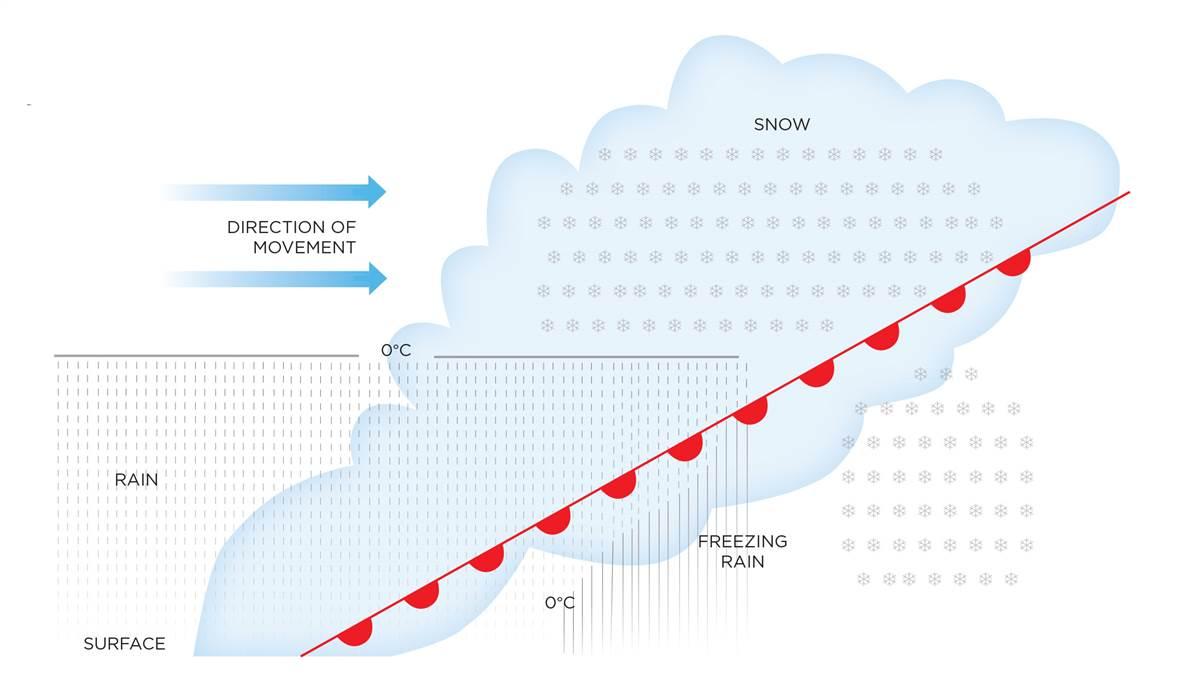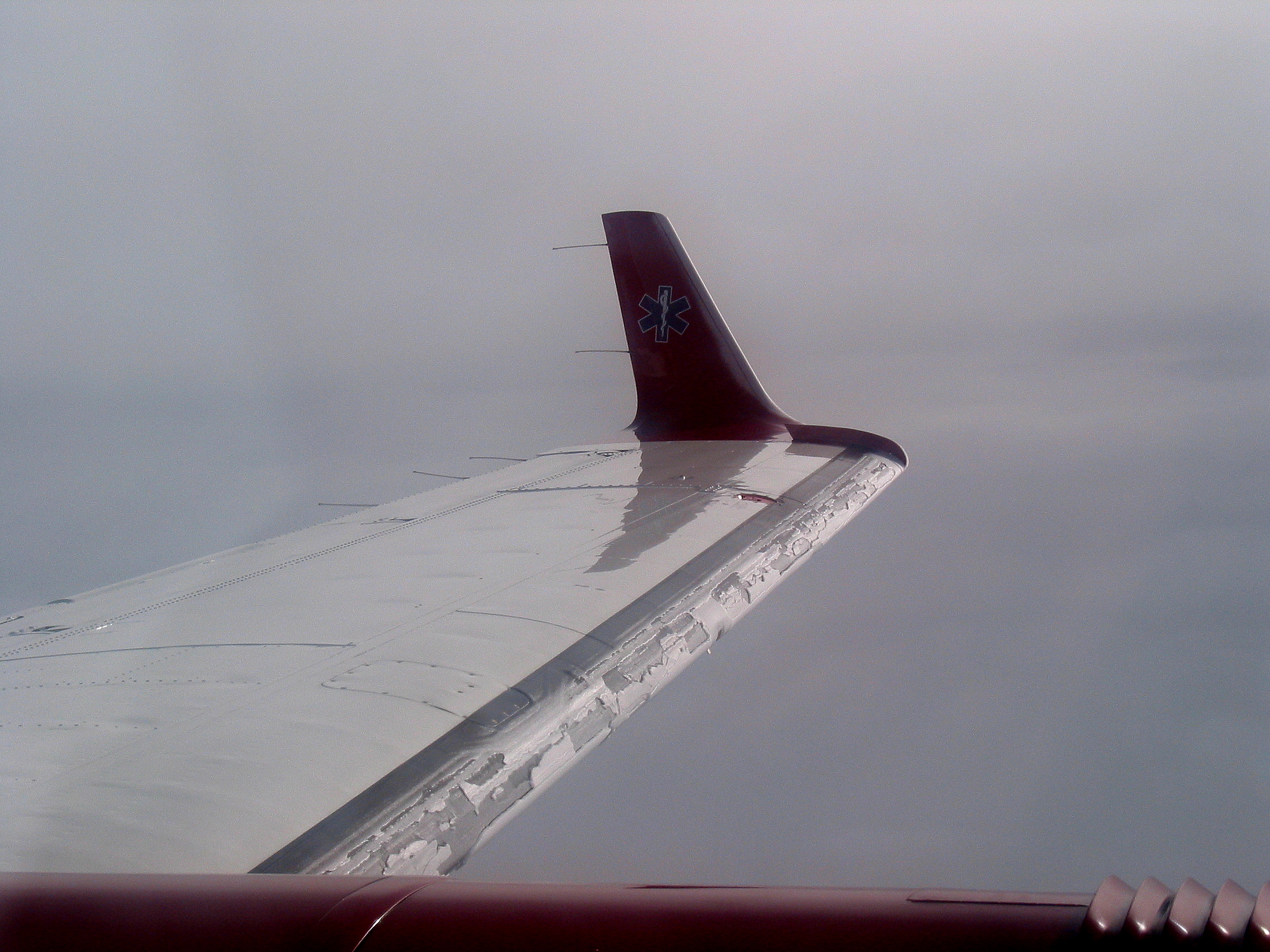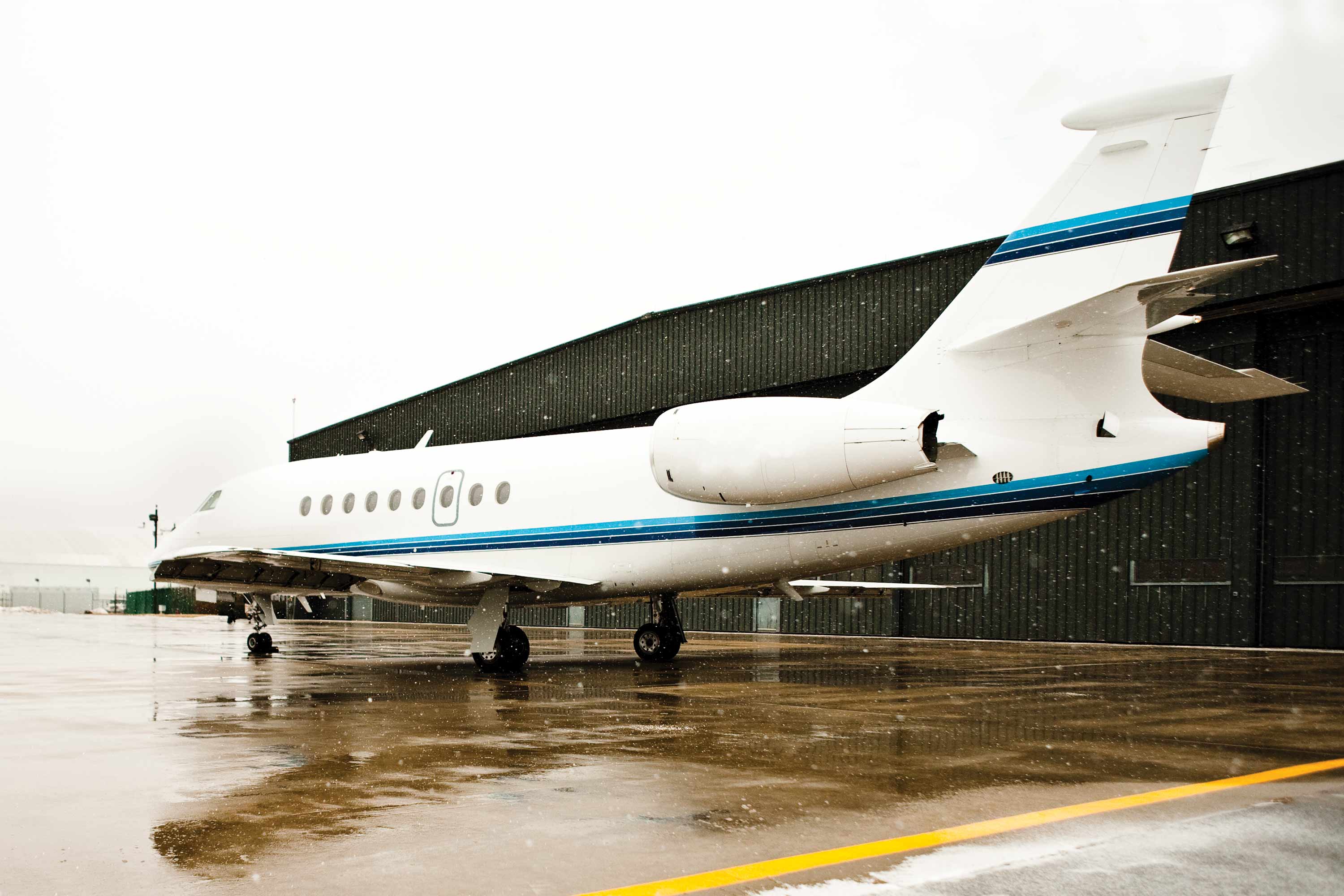Types Of Aircraft Icing - Ice can collect on the surface of the plane and hamper the function of the wings, propellers and control surface as well as canopies and windscreens, pitot tubes, static vents, air intakes, carburetors and radio antennas.
On 21 December 2015, a Boeing 787-8 at FL400 in the vicinity of convective weather conducive to ice crystal icing penetrated an area which included maximum intensity weather radar returns. A very short period of erratic airspeed indications followed and the FCS reverted to Secondary Mode requiring manual flying.
Types Of Aircraft Icing

Since this Mode remained 'latched' and could therefore only be reset on the ground, it was decided that an en route diversion was appropriate and this was accomplished without further incident. Boeing subsequently modified the FCS software to reduce the chances of reversion to Secondary Mode in short-duration unreliable airspeed events.
Icing Forecasts
On 15 February 2013, an Embraer EMB-500 Phenom 100 crew lost control of their aircraft shortly before touchdown at Berlin Schönefeld when it stalled and crash-landed. The Investigation was not completed for almost six years but concluded that the stall was a result of ice accretion during an approach in icing conditions without activation of the airframe de icing system.
It found poor crew awareness of both the ice and stall protection systems and, suspecting that this may be true of other type-rated pilots, accordingly made Safety Recommendations to key regulatory authorities concerning the type rating syllabus.
Ice may accumulate unevenly on the blades and, as a result, they may go out of balance. This will result in vibrations that will place undue stress on the blades as well as the engine mounts, which may cause them to fail.
People may be surprised that icing is a problem that has not been solved, and McClain recognizes that it has been studied for many decades. He adds, "It is a really hard problem. It’s a multi-phase multi-species, transient non-equilibrium thermodynamics problem.
How An Aircraft Is Affected By Icing
Getting the amount of water that hits a specific location on the aircraft surface over a matter of a time is still a difficult computational task.” "Typically in my laboratory we are improving the 3D CFD codes that are used by all the manufacturers, once they take a vehicle design to start the certification process," says Steve McClain, mechanical engineering professor at Baylor University.
How icing affects an aircraft's performance and ways to mitigate the impact of icing on airframes is a major area of R&D. The recent improvements in battery technology are leading to new types of aircraft that need icing protection.
Ice protection company CAV Systems' engineering, product development and delivery vice president, Alexander Baty says, "There is more interest in urban air mobility. We are seeing a lot of interest from startup companies. "With these aircraft, their flight endurance is low.

We don’t need as big a tank of anti-icing fluid as on traditional aircraft. We're seeing more interest from other areas. The first example would be military drones, things like the General Atomics Aeronautical Systems Predator B. We’ve done three or four different systems on those types of aircraft.”
Icing Severity
With all the above caveats, a brief look at the usual 'descriptions' and 'definitions' of icing conditions used by forecasters may still be helpful. The descriptions all assume that an aircraft is certified for "flight in icing conditions".
On 11 January 2017, control of a Cessna Citation 560 departing Oslo on a short positioning flight was lost control during flap retraction when a violent nose-down maneuver occurred. The First Officer took control when the Captain did not react and recovered with a 6 g pullout which left only 170 feet of ground clearance.
A MAYDAY - subsequently canceled when control was regained - was declared and the intended flight was then completed without further incident. The Investigation concluded that tailplane stall after the aircraft was not de-iced prior to departure was the probable cause of the upset.
The majority of supercooled droplets in clouds are between 1 micron (0.001 mm) and 50 microns (0.05 mm) in diameter. (For comparison, the thickness of the average human hair is approximately 100 microns). Layer (stratiform) clouds typically contain average droplet diameters of up to 40 microns.
Clouds And Supercooled Moisture
Vertically developed (cumuliform) clouds of moderate scale typically have average droplet diameters of up to 50 microns (0.05mm) but large Cumulonimbus (Cb) clouds often contain much more liquid water, including large quantities in droplets with diameters up to and beyond 100 microns
(0.1mm). The aircraft testing equipment was developed during the first part of the project explains Carsten Schwarz, SENS4ICE coordinator. Schwarz leads the flight mechanics group at the DLR Institute of Flight Systems, Department of Flight Dynamics and Simulation.
Super cooled large droplet icing is SENS4ICE's focus and the project has several different approaches to testing for that. If the engine's propeller is building up ice, then the same thing will be happening on tail surfaces, wings, and other projections.
The accumulated ice's weight isn't as serious as the disruption of airflow it causes around the tail surface and wings. Intercycle ice is that which forms between cyclic activation of a mechanical or thermal de-ice system.
Ice From Supercooled Moisture
Accumulation of some ice when these systems are not 'on' is an essential part of their functional design. The time interval between 'on' periods is usually selectable between at least two settings. Any ice remaining after a de-icing system of this type has been selected off is sometimes referred to as residual ice.
He explains that one of the technologies being used takes an optical approach. This detection technology is called shadography and involves the detection of droplets visually in images. Super cooled droplets are also important to McClain's work at Baylor, which seeks to improve understanding of the physics of how droplets accrete on an aircraft's surface.
Clear or Glaze ice is formed by larger supercooled water droplets, of which only a small portion freezes immediately. This results in runback and progressive freezing of the remaining liquid and since the resulting frozen deposit contains relatively few air bubbles as a result, the accreted ice is transparent or translucent.
If the freezing process is sufficiently slow to allow the water to spread more evenly before freezing, the resulting transparent sheet of ice may be difficult to detect. The larger the droplets and the slower the freezing process, the more transparent the ice.
Icing In Cloud And Precipitation
On 14 November 2016, an ATR72-600 crew lost control at FL150 in severe icing conditions. Uncontrolled rolls and a 1,500 feet height loss followed during an apparent stall. After recovery, the Captain announced to the alarmed passengers that he had regained control and the flight was completed without further incident.
The Investigation found that the crew had been aware that they had encountered severe icing rather than the forecast moderate icing but had attempted to continue to climb which took the aircraft outside its performance limitations.
The recovery from the stall was non-optimal and two key memory actions were overlooked. On 20 October 2013, a Boeing 757-200 Co-Pilot believed his aircraft was at risk of stalling when he saw a sudden low airspeed indication on his display during a night descent and reacted by increasing thrust and making abrupt pitch-down inputs.
Other airspeed indications remained unaffected. The Captain took control and recovery to normal flight followed. The excursion involved a significant Vmo excess, damage to and consequent failure of one of the hydraulic systems and passengers and cabin crew injuries.
The Adverse Aerodynamic Effects Of Accreted Ice
The false airspeed reading was attributed by the Investigation to transient Ice Crystal Icing affecting one of the pitot tests. Rime ice accumulates on the wings' leading edges and on pilot heads, antennas, etc. For rime ice to form on the aircraft, the temperature of the aircraft's skin should be below 0°C.

Due to the low temperature, the droplets will quickly and completely freeze. Even after freezing, droplets do not lose their spherical shape. In North America, the terms clear, rime or mixed are more often used in forecast material than elsewhere and are both intended and taken as a proxy for droplet size regardless of other factors such as temperature and liquid water content.
In this use, a forecast of rime icing indicates smaller drop sizes and a forecast of mixed or clear icing indicates larger drop sizes but with only a vague and undefined boundary between the two. Since rime ice forms on leading edges, it can affect the aerodynamic characteristics of both wings and horizontal stabilizers as well as restricting engine air inlets.
Rime may begin to form as a rough coating of a leading edge but if accretion continues, irregular protrusions may develop forward into the airstream, although there are structural limits to how much "horn" development can occur.
Freezing Rain And Freezing Drizzle
Partial or complete blockage of the air inlet to any part of a pitot static system can produce errors in the readings of pressure instruments such as Altimeters, Airspeed indicators, and Vertical Speed Indicators. The most likely origin of such occurrences to otherwise serviceable systems has been the non-activation of the built-in electrical heating which these tubes and plates are provided with, although in some cases, the detail design of pitot heads has made them relatively more vulnerable
to ice accretion even when functioning as certified. It is now also recognized that the effects of high level ice crystal icing can have what are usually transient effects on the effectiveness of normally functioning pitot probe heating.
Ice accretion on critical parts of an airframe unprotected by a normally functioning anti-icing or de-icing system can modify the airflow pattern around airfoil surfaces such as wings and propeller blades leading to loss of lift, increased drag and a shift in the airfoil center
of pressure. The latter effect may alter longitudinal stability and pitch trim requirements. Longitudinal stability may also be affected by a degradation of lift generated by the horizontal stabilizer. The modified airflow pattern may significantly alter the pressure distribution around flight control surfaces such as ailerons and elevators.
Engine Air Inlet Icing
If the control surface is unpowered, such changes in pressure distribution can eventually lead to uncommanded control deflections which the pilot may not be able to be overpowered. "Most of the heat transfer measurements that I do at Baylor are still what are called dry measurements," McClain explains.
"So, we look at something like a scale roughness model and consider how that affects the dry heat transfer and make some assumptions about what goes on when you have a multi-phased situation on a real ice surface."

Runback ice forms when supercooled liquid water moves aft on the upper surface of the wing or tailplane beyond the protected area and then freezes as clear ice. Forms of ice accretion which are likely to be hazardous to continued safe flight can quickly build up.
Runback is usually attributable to the relatively large size of the SLD encountered but may also occur when a thermal ice protection system has insufficient heat to evaporate the amount of supercooled water impinging on the surface.
Snow in itself does not present an icing threat, since the water is already frozen. However, snow can be mixed with liquid water, particularly cloud droplets, and, in some circumstances, can contribute to the accumulation of hazardous frozen deposits.
This phenomenon may also occur in Cumulonimbus anvil clouds, where the ice crystals may be mixed with SLD to incur significant icing. On December 13, 2017, control of an ATR 42-300 was lost just after it became airborne at night from Fond-du-Lac and it was destroyed by the subsequent terrain impact.
Ten occupants sustained serious injuries from which one later died and all others sustained minor injuries. The Investigation found that the accident was primarily attributable to pre-takeoff ice contamination of the airframe with an inappropriate pilot response then preventing an achievable recovery.
It was found that significant airframe ice accretion had gone undetected during an inadequate pre-flight inspection and that there was a more widespread failure to recognize airframe icing risk. If a SLD is large enough, its mass will prevent the pressure wave traveling ahead of an airfoil from deflecting it.
When this occurs, the droplet will impinge further aft than a typical cloud-sized droplet, possibly beyond the protected area and form clear ice. On 3 October 2014, the crew of a Saab 340 in the cruise at FL150 in day IMC did not recognize that severe icing conditions had been encountered early enough to make a fully-controlled exit from them and although recovery from the subsequent stall was successful,
it was achieved in a non-standard manner. The Investigation concluded that although both mountain wave effects and severe icing had contributed to the incident, the latter had been the main cause. Both crew understanding of airframe icing risk and supporting Operator and Manufacturer documentation on the subject were considered deficient.
Any cloud containing liquid water can present a significant icing environment if the temperature is 0 °C or less. Generally, cumuliform cloud structures will contain relatively large droplets which can lead to very rapid ice build up.

Stratiform cloud structures usually contain much smaller droplets, although the horizontal extent of icing conditions within a stratiform cloud may be such that the accumulation in even a relatively short period of level flight can sometimes be considerable.
The most significant ice accretion in any cloud can be expected to occur at temperatures below, but close to, 0˚C. In a stratiform cloud in temperate latitudes, the maximum ice accretion is often found near the top of the cloud and it may be unwise for some turboprop aircraft to remain at such an altitude for extended periods.
Vibrations resulting from the unequal loading on the propeller blades and wings are also dangerous for the flight. When large blocks of clear ice break off, vibrations may become so severe that they might impair the aircraft's structure.
When clear ice is mixed with sleet or snow, it might appear whitish. Any drizzle or rain which is encountered at temperatures of freezing or below is likely to generate significant ice accretion in a very short period of time, even if reasonable forward visibility prevails, and such conditions should be exited by any appropriate change of flight path.
It is this vastly greater mass of supercooled water droplets in freezing precipitation compared to those in cloud, even cumulonimbus cloud, which precludes any aircraft undertaking a significant period of sustained flight - and in most cases any flight - in freezing precipitation clear of cloud.
Airflow is severely disrupted by this unique formation of ice and it increases the drag in the flight by about 300 percent to 500 percent. Clear ice is extremely dangerous because it makes the aircraft lose lift as it alters wing camber and disrupts the flow of air over the tail surface and wings of the aircraft.
Moreover, it increases drag which is dangerous for the plane. Ice shed during in-flight de icing is not of a size which could create a hazard should it survive in frozen form until reaching the ground below.
However, there has been a long history of ice falls from aircraft waste drain masts, a few of which have caused minor property damage and occasionally come close to hitting and injuring people. The drain masts involved are those from aircraft galleys or toilet compartments which are normally heated to prevent ice formation but for some reason have not been operating as intended.
Ice from toilet waste masts is often referred to as "blue ice". Most of these events have been recorded where there is a high density of long haul commercial air traffic inbound to a large airport which routinely overflies a densely populated residential area as it descends below the freezing level in the vicinity of the airport.
icing on aircraft, rime icing aircraft, aircraft icing accidents, aircraft icing temperatures, clear icing aircraft, airplane ice, mixed icing aircraft
